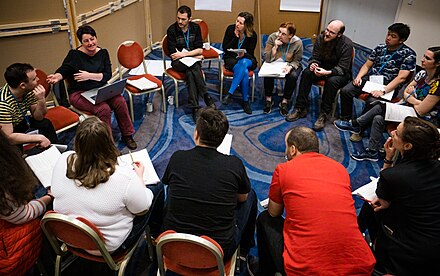Strategy/Wikimedia movement/2018-20/Reports/Movement Strategy Playbook/Use the right collaboration tools
| “ | It can be frustrating to balance
the ideals of open teamwork with the realities of bureaucratic processes, systems and tools. |
” |
Effective teamwork and collaboration is all about agreeing on the right rhythm, practices, and tools — as opposed to a more ad hoc, “everybody just figure it out on your own” approach. Using the right project management tools to track tasks can dramatically increase the group’s effectiveness, increase asynchronous work, and reduce the need for meetings and email.

- “I came in with the assumption that Wikimedians are really good at communicating and connecting remotely, using digital tools, etc. But the challenge is around *joint* work. Wikimedians are used to working individually — the workflow for collaborative work was much harder.”
Set clear rituals for prioritizing and tracking work
editHave clear working agreements for what tools you’ll use to prioritize and manage work. This can also help reduce unnecessary meetings and email.
- “Having a clear meeting structure and roles creates frequent touch points for communication across the team.“
- “Facilitating good internal team meetings is a huge amount of emotional labor, but was invaluable to helping our time together be fruitful.”
- “Weekly close-out meetings were successful as a way to report out on what we all had done, to ensure key milestones of the week had been hit. They ensured common understanding across the entire project, to focus and ensure we had the right conversations at the right time with the right people.”
Reduce meeting fatigue
edit“Too many meetings” or “meetings by default” is a common pain-point for participants.
- “At times we were over communicating and drowning in calls, yet not much was happening and we were going around in loops.”
- “There were too many meetings, and too many people at meetings. To me, this was about a lack of clarity about team objectives and roles.”
- “Another problem is the assumption that everyone should be at almost every meeting — when in reality only a few key stakeholders are needed. This wastes a lot of time.”
- “Team calls should serve higher-level purposes, like building momentum before major openings, sunsetting phases, and the exchange of knowledge and experience.”
Use tools to make tasks more visual and transparent
editDifferent groups have their own preferred method or tool for tracking tasks and who is doing what. The important thing is to commit to some kind of shared norm or practice that works for the group.
- “Having communication on Asana cards to support event planning and travel was life-saving! It allowed us to get the information asynchronously not lose track between the hundreds of travelers and the many processes”
- “Having someone clearly log tasks helps people to be present in the meeting is invaluable. Always have 1 or 2 support people to provide this follow-up & project management support. It creates shared transparency and understanding in the team.”
- “[Our project managers] worked very hard to keep track of all key information on Asana -- meetings, milestones, tasks, etc. I am deeply grateful for this level of detailed work that helped keep me and others on track.”
- “Using Google tools to share information and connect our work helped a lot. I wish we had our own internal tools, but, while we don't, these served pretty well.”
Set clear working agreements for how and when you’re using each tool
editEveryone’s work style is different, and it’s ok if people in the group use these tools differently — so long as you have clear understanding and working agreements around them.
- “It would have made our lives easier if the whole team had consistently used Asana, so that we could have tracked the progress, potential delays, need for support and information better.”
- “Onboarding helps here. Explain the rationale + purpose behind the tool — eg, as a way to save work versus creating extra effort.”
- “Design, style and structure makes a big impact, in terms of how you set up and use these collaboration tools. It’s about the design and working agreements, not just: ‘hey, use this tool!’”
Tools and examples for effective collaboration
editDo you have tools, methods or ideas that you, your community or organization use for this? Add them to this section for others to see.